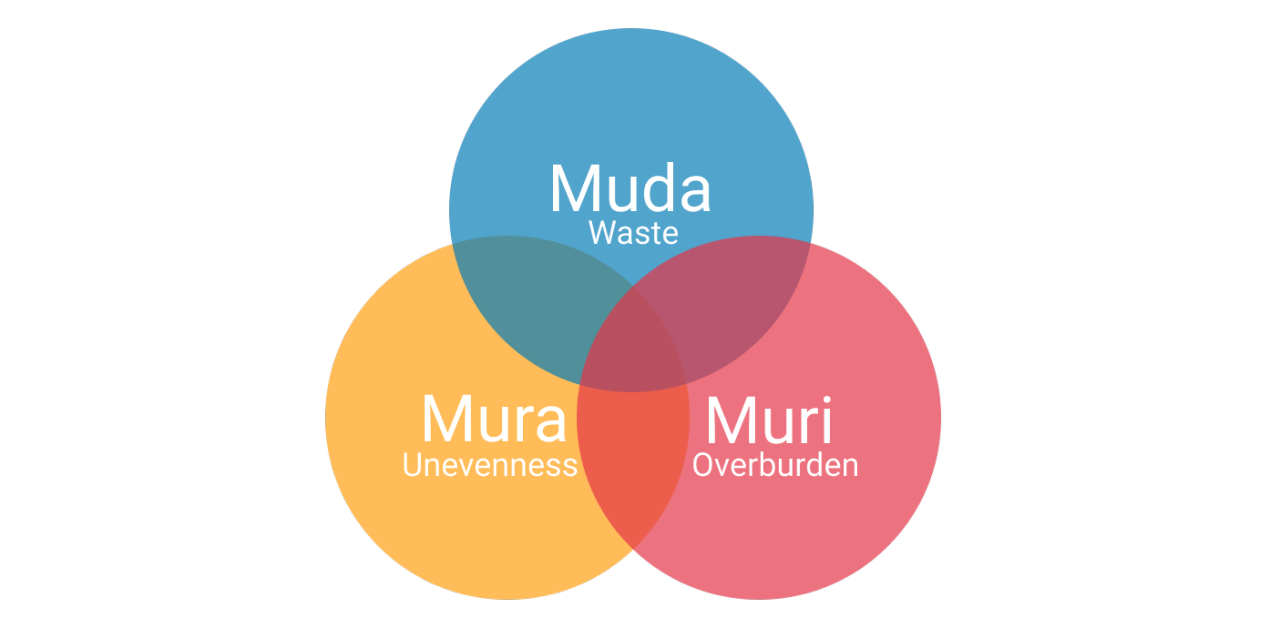
Toyota Production System (TPS) Muda, Mura and Muri
Toyota has developed its production system around eliminating three enemies of Lean: Muda (waste), Muri (overburden), and Mura (unevenness)
Muda (wastefulness)
Muda means wastefulness, uselessness, and futility, which is contradicting value-addition. Value-added work is a process that adds value to the product or service that the customer is willing to pay for. There are two types of Muda, Type 1 and Type 2. Muda Type 1 includes non-value-added activities in the processes that are necessary for the end customer. For example, inspection and safety testing does not directly add value to the final product; however, they are necessary activities to ensure a safe product for customers. Muda Type 2 includes non-value added activities in the processes, but these activities are unnecessary for the customer. As a result, Muda Type 2 should be eliminated.
There are seven categories of waste under Muda Type 2 that follow the abbreviation TIMWOOD.
1) Transport i.e. excess movement of product
(2) Inventory i.e. stocks of goods and raw materials,
(3) Motion i.e. excess movement of machine or people
(4) Waiting
(5) Overproduction
(6) Over-processing
(7) Defects.
Mura (unevenness)
Mura means unevenness, non-uniformity, and irregularity. Mura is the reason for the existence of any of the seven wastes. In other words, Mura drives and leads to Muda. For example, in a manufacturing line, products need to pass through several workstations during the assembly process. When the capacity of one station is greater than the other stations, you will see an accumulation of waste in the form of overproduction, waiting, etc. The goal of a Lean production system is to level out the workload so that there is no unevenness or waste accumulation.
Mura can be avoided through the Just-In-Time ‘Kanban’ systems and other pull-based strategies that limit overproduction and excess inventory. The key concept of a Just-In-Time system is delivering and producing the right part, at the right amount, and at the right time
Kanban (signal card)
Kanban is considered a “lean production” technique, or one that eliminates labor and inventory waste. One of the ways Kanban reduces waste is through the “pull production” model that regulates item production based on consumer supply and demand.
Muri (overburden)
means overburden, beyond one’s power, excessiveness, impossible, or unreasonableness. Muri can result from Mura and in some cases be caused by excessive removal of Muda (waste) from the process. Muri also exists when machines or operators are utilized for more than 100% capability to complete a task or in an unsustainable way. Muri over a period of time can result in employee absenteeism, illness, and breakdowns of machines. Standardize work can help avoid Muri by designing the work processes to evenly distribute the workload and not overburden any particular employee or equipment.
Relationship between Muda, Mura, and Muri
Lean Manufacturing is about the removal of waste; but not just Muda (non-value-adding steps), it is about removing Mura and Muri too. In fact, by concentrating on solving Mura and Muri you prevent the creation of Muda.
By working on Just in Time (JIT) principles with Heijunka, Kanban, and other techniques you enable production smoothing and flow; removing the causes of Mura, unevenness. The other lean tools such as 5S and TPM help you to remove other causes of overburden removing Muri, overburden




SCM Country Lead at Recover | Leading Cost-Effective SCM Operations( Warehouses and Logistics ) Specialized on Lean Manufacture, 6S, WMS, Oracle, SAP, D-365.
1moWell Said, good to learn by easiest way